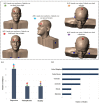Notes on Human Trials of Transcranial Direct Current Stimulation between 1960 and 1998
- PMID: 28280463
- PMCID: PMC5322235
- DOI: 10.3389/fnhum.2017.00071
Notes on Human Trials of Transcranial Direct Current Stimulation between 1960 and 1998
Abstract
Background: Transcranial direct current stimulation (tDCS) is investigated to modulate neuronal function including cognitive neuroscience and neuropsychiatric therapies. While cases of human stimulation with rudimentary batteries date back more than 200 years, clinical trials with current controlled stimulation were published intermittently since the 1960s. The modern era of tDCS only started after 1998. Objectives: To review methods and outcomes of tDCS studies from old literature (between 1960 and 1998) with intention of providing new insight for ongoing tDCS trials and development of tDCS protocols especially for the purpose of treatment. Methods: Articles were identified through a search in PubMed and through the reference list from its selected articles. We included only non-invasive human studies that provided controlled direct current and were written in English, French, Spanish or Portuguese before the year of 1998, the date in which modern stimulation paradigms were implemented. Results: Fifteen articles met our criteria. The majority were small-randomized controlled clinical trials that enrolled a mean of approximately 26 subjects (Phase II studies). Most of the studies (around 83%) assessed the role of tDCS in the treatment of psychiatric conditions, in which the main outcomes were measured by means of behavioral scales and clinical observation, but the diagnostic precision and the quality of outcome monitoring, including adverse events, were deficient by modern standards. Compared to modern tDCS dose, the stimulation intensities used (0.1-1 mA) were lower, however as the electrodes were typically smaller (e.g., 1.26 cm2), the average electrode current density (0.2 mA/cm2) was approximately 4× higher. The number of sessions ranged from one to 120 (median 14). Notably, the stimulation session durations of several minutes to 11 h (median 4.5 h) could markedly exceed modern tDCS protocols. Twelve studies out of 15 showed positive results. Only mild side effects were reported, with headache and skin alterations the most common. Conclusion: Most of the studies identified were for psychiatric indications, especially in patients with depression and/or schizophrenia and majority indicated some positive results. Variability in outcome is noted across trials and within trials across subjects, but overall results were reported as encouraging, and consistent with modern efforts, given some responders and mild side effects. The significant difference with modern dose, low current with smaller electrode size and interestingly much longer stimulation duration may worth considering.
Keywords: brain; electric stimulation therapy; human; review; tDCS.
Figures


Similar articles
-
Transcranial direct current stimulation for the treatment of tinnitus: a review of clinical trials and mechanisms of action.BMC Neurosci. 2018 Oct 25;19(1):66. doi: 10.1186/s12868-018-0467-3. BMC Neurosci. 2018. PMID: 30359234 Free PMC article. Review.
-
a-tDCS differential modulation of corticospinal excitability: the effects of electrode size.Brain Stimul. 2013 Nov;6(6):932-7. doi: 10.1016/j.brs.2013.04.005. Epub 2013 Apr 28. Brain Stimul. 2013. PMID: 23664681 Clinical Trial.
-
The Effect of Transcranial Direct Current Stimulation (tDCS) Electrode Size and Current Intensity on Motor Cortical Excitability: Evidence From Single and Repeated Sessions.Brain Stimul. 2016 Jan-Feb;9(1):1-7. doi: 10.1016/j.brs.2015.08.003. Epub 2015 Aug 14. Brain Stimul. 2016. PMID: 26350410
-
Tolerability of Repeated Application of Transcranial Electrical Stimulation with Limited Outputs to Healthy Subjects.Brain Stimul. 2016 Sep-Oct;9(5):740-754. doi: 10.1016/j.brs.2016.05.008. Epub 2016 May 24. Brain Stimul. 2016. PMID: 27372844 Free PMC article. Clinical Trial.
-
Transcranial Magnetic and Direct Current Stimulation (TMS/tDCS) for the Treatment of Headache: A Systematic Review.Headache. 2019 Mar;59(3):339-357. doi: 10.1111/head.13479. Epub 2019 Jan 23. Headache. 2019. PMID: 30671941
Cited by
-
Toward comprehensive tDCS safety standards.Brain Behav Immun. 2017 Nov;66:413. doi: 10.1016/j.bbi.2017.08.007. Epub 2017 Aug 9. Brain Behav Immun. 2017. PMID: 28803157 Free PMC article. No abstract available.
-
How to consider animal data in tDCS safety standards.Brain Stimul. 2017 Nov-Dec;10(6):1141-1142. doi: 10.1016/j.brs.2017.08.004. Epub 2017 Aug 18. Brain Stimul. 2017. PMID: 28851553 Free PMC article. No abstract available.
-
Adaptive current tDCS up to 4 mA.Brain Stimul. 2020 Jan-Feb;13(1):69-79. doi: 10.1016/j.brs.2019.07.027. Epub 2019 Aug 5. Brain Stimul. 2020. PMID: 31427272 Free PMC article.
-
Effects of tACS-Like Electrical Stimulation on Correlated Firing of Retinal Ganglion Cells: Part III.Eye Brain. 2022 Jan 12;14:1-15. doi: 10.2147/EB.S313161. eCollection 2022. Eye Brain. 2022. PMID: 35046742 Free PMC article.
-
Transcranial electrical stimulation nomenclature.Brain Stimul. 2019 Nov-Dec;12(6):1349-1366. doi: 10.1016/j.brs.2019.07.010. Epub 2019 Jul 17. Brain Stimul. 2019. PMID: 31358456 Free PMC article. Review.
References
-
- Baker A. (1970). Brain stem polarization in the treatment of depression. S. Afr. Med. J. 44, 473–475. - PubMed
-
- Benton A. L. (1946). A Visual Retention Test for Clinical Use. New York, NY: Psychological Corporation.
Publication types
Grants and funding
LinkOut - more resources
Full Text Sources
Other Literature Sources
Miscellaneous

